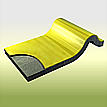
The most common alloys are: brass (zinc-copper 70%) for decoration and for improving the adhesion between steel and rubber; bronze (90% copper, 10% tin), against adhesive wear; with 40-45% of copper, bronze is used against corrosion.
Other rarely used alloys are: lead-tin (tin 6%) for corrosion protection, (tin 60%) as soldering metal; nickel-iron (iron 40%) to replace nickel when too costly; nickel-tin (tin 65%) for corrosion resistance even in very highly acid environments.
Danish Name
Category
Materials
Brass (Cu-Zn) Bronze (Cu-Sn)
Lead-Tin Nickel-Iron Nickel-Tin
Typical products
ReferencesDegussa AG
Galvanisk Kompagni A/S
Price notes
| DKK/part | 5 parts | 100 | 5000 |
| Small (1cm2) | 84/84 | 11/11 | 0.056/0.041 |
| Medium (1dm2) | 115/113 | 20/18 | 0.44/0.26 |
| Large (100dm2) | 210/171 | 93/54 | 31/13 |
Price date
Environmen- tal notes
Disposal: Tin and copper can be problematic when recycling steel.
Additional info
Photo
Copyright
This page is part of Design inSite
Disclaimer